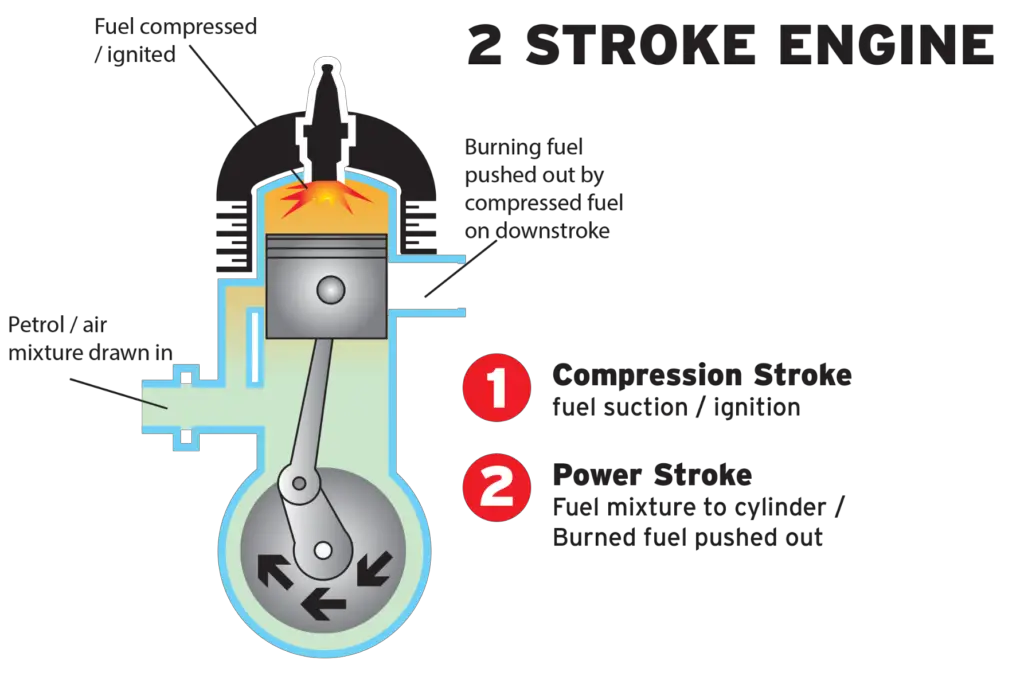Two-stroke engines are often used in small motorbikes, mopeds, and scooters. While these engines are easy to maintain and operate, they need 2-stroke oils.
In this article, we will explore what is a 2-stroke engine and why it is important to use a special 2-stroke oil when operating one of these engines.
What Is a 2-Stroke Engine?
A 2-stroke engine is a type of internal combustion engine that completes a power cycle in just two strokes of the piston, instead of the four strokes used in a 4-stroke engine. The components of a 2-stroke engine are lesser and lighter than the 4-stroke engine, but also less efficient and more polluting.
It is commonly used in machines that require a high power-to-weight ratio, such as chainsaws, mopeds machine, dirt bikes, jet skis, and some outboard boat motors.

Why Do You Need a Special Oil for 2-Stroke Engines?
2-stroke engines require a special oil for several reasons:
Lubrication
2-stroke engines require oil to lubricate their moving parts, such as the crankshaft, piston, and bearings. Without sufficient lubrication, the engine would experience excessive wear and damage, leading to poor performance and a shorter lifespan.
Combustion
In 2-stroke engines, the oil is mixed with the fuel and burned along with it in the combustion chamber. This means that the oil needs to be able to burn cleanly without leaving behind harmful residues that could clog the engine or increase emissions.
Cooling
The oil in a 2-stroke engine also helps to cool the engine by carrying away heat from the combustion process. Without proper cooling, the engine could overheat and suffer damage.
Mixing
Unlike 4-stroke engines that have a separate oil reservoir, 2-stroke engines require the oil to be mixed with the fuel before being added to the engine. This means that the oil needs to be able to mix easily with the fuel without separating or causing problems with fuel delivery.
Best 2-Stoke Engine Oils
We’ve done the research and found three great 2-stroke engine oils, so you don’t have to.
1. Briggs & Stratton 2-Cycle Easy Mix Motor Oil

If you’re in need of a good quality oil for your 2-stroke engine, Briggs & Stratton 2-Cycle Easy Mix Motor Oil is an excellent option to consider. Here are some reasons why:
Firstly, it comes in pre-measured bottles, which make it super easy to mix the correct amount of oil with your gasoline. This ensures that you always have the right oil-to-fuel ratio, which is important for optimal engine performance.
Secondly, this oil is designed to protect your engine from wear and tear. It’s specially formulated to provide excellent engine protection, which can help your engine last longer and run more smoothly.
Thirdly, the Briggs & Stratton 2-Cycle Easy Mix Motor Oil burns cleanly and doesn’t leave behind harmful deposits. This is important for reducing emissions and keeping your engine running efficiently.
Lastly, this oil is versatile and can be used in a wide range of 2-stroke engines, which makes it a convenient choice for those who have multiple pieces of outdoor power equipment.
Overall, the Briggs & Stratton 2-Cycle Easy Mix Motor Oil is a great choice for anyone who needs a reliable and easy-to-use oil for their 2-stroke engines.
2. Pennzoil Marine XLF Engine Oil

Pennzoil Marine XLF Engine Oil is a high-quality oil that is designed for use in 2-stroke marine engines. Here are some reasons why you might want to choose this oil:
It provides excellent engine protection. The oil is formulated to protect your engine from wear and tear, which can help it last longer and run more smoothly.
In addition to that, Pennzoil Marine XLF Engine Oil is designed to burn cleanly and reduce emissions. This is important for meeting environmental regulations and keeping your engine running efficiently.
Furthermore, this oil is specifically designed for use in marine environments. It can withstand the harsh conditions of saltwater and prevent corrosion, which is important for maintaining the longevity of your engine.
Lastly, Pennzoil Marine XLF Engine Oil is a trusted brand with a long history of producing high-quality products. You can feel confident in the quality of this oil and trust that it will keep your engine running smoothly.
Overall, if you’re in need of high-quality oil for your 2-stroke marine engine, Pennzoil Marine XLF Engine Oil is definitely worth considering.
3. Husqvarna XP+ 2 Stroke Oil

Husqvarna XP+ 2 Stroke Oil is an excellent choice for anyone who wants to maintain the optimal performance of their 2-stroke engine. This oil is specifically designed to provide superior engine protection and performance, making it an ideal choice for those who demand the best from their equipment.
One of the key benefits of Husqvarna XP+ 2 Stroke Oil is its superior engine protection. The oil is formulated with high-quality synthetic base oils, which offer superior performance and protection compared to traditional mineral-based oils. This means that your engine will be better protected against wear and tear, resulting in improved performance and a longer lifespan.
Another benefit of this oil is that it burns cleanly and reduces exhaust emissions, making it an environmentally friendly choice. This is important for those who want to reduce their environmental impact and comply with emissions regulations.
Lastly, the Husqvarna XP+ 2 Stroke Oil is a trusted brand with a long history of producing high-quality products. It is specifically designed for use in Husqvarna 2-stroke engines, but can also be used in other brands of outdoor power equipment.
Overall, if you want to ensure that your 2-stroke engine is well-protected and performing at its best, Husqvarna XP+ 2 Stroke Oil is an excellent choice. Its superior engine protection, clean-burning formula, and high-quality synthetic base oils make it a reliable and efficient option for anyone who wants to keep their equipment running smoothly.
How To Change 2-Stroke Oil?
Changing the oil in a 2-stroke engine is an important part of routine maintenance that can help to ensure proper engine operation and extend the life of the engine. Here are five steps to follow to change the oil in a 2-stroke engine.

Step 1: Warm Up the Engine
Before changing the oil, warm up the engine by running it for a few minutes. This will help to loosen the old oil and make it easier to drain.
Step 2: Drain the Old Oil
Once the engine is warmed up, turn it off and place an oil pan beneath the drain plug. Remove the drain plug and drain the old oil into the pan. Be sure to dispose of the old oil properly according to your local regulations.
Step 3: Replace the Drain Plug
Once the old oil has been drained, replace the drain plug.
Step 4: Fill With Fresh 2-Stroke Oil
Fill the engine with fresh 2-stroke oil, using a funnel to prevent spills. Refer to the owner’s manual for the recommended type and amount of oil to use.
Step 5: Check the Oil Level
Check the oil level with the dipstick or sight glass, and add more oil as needed to bring it to the proper level.
In summary, changing the oil in a 2-stroke engine involves warming up the engine, draining the old oil, replacing the drain plug, filling it with fresh 2-stroke oil, and checking the oil level. Following these steps on a regular basis can help to keep your 2-stroke engine running smoothly and efficiently.
Final Thoughts: Why Do You Need a Special 2-Stroke Oil?
Conclusively, two-stroke oils include detergents and additives that help reduce emissions and ensure a clean engine; they also keep your engine running smoothly and efficiently. If you own a two-stroke vehicle, make sure you choose the right oil in the correct ratio in order to get the best performance possible from your engine.
For more engine-oil-related queries, explore our blog on engine oils.



